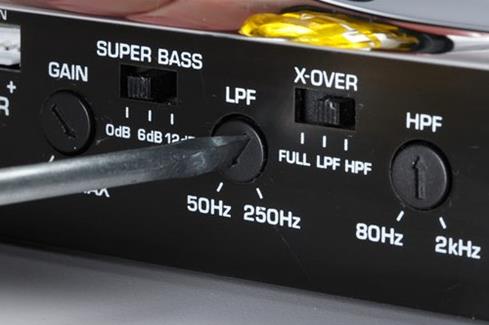

For the receiver I set the mains to small and the crossover at 80Hz then just hooked REW to stereo inputs and measured the sub line output. If the polarity is wrong the lights on the EP2500 will light up.
SUBSONIC FILTER SERIES
Maybe try it out with a 10k resistor in series first. You must use unbridged mode and also the ground (black) output from the amp must go the ground of your sound card. Even though they may only contribute less than 1dB in this range, there are several so they add up and should be considered.įor the EP2500, I just was careful with the gain setting before looping it back to my sound card. This provides the greatest accuracy in the range that you are interested in: 10-20Hz. I limited the fitting range from about the -6dB point up to about 2-3 octaves above the cutoff frequency. You just have to decide what part of the data is important for the fitting. I then used the solver to fit the filter cutoff frequency and order to the data. I saved that data to text and opened it up in excel. I used REW and a sweeps up to 200Hz to find those cutoffs. I would guess that they would be within 10% of my measurements because of combined tolerances of electrical components. Which suggests that simple calculation is not indicative of the amplifier's control over the cone.Īlso being old enough to have only had analogue tape or vinyl sources, cone flap was not considered out of the ordinary.Click to expand.They will vary primarily because of component tolerances. I once connected a DC coupled amp to a drive unit and tapped the cone and then repeated it after disconnecting the amp. Back emf is the release of inductor energy once the drive has been removed, but as the amplifier is now driving in the opposite direction the maths will be a little more complex, and a factor of 4 might be a long way off. I say common knowledge because some rubbish the whole idea of damping factor.
SUBSONIC FILTER FULL
It's always a good idea to do a lot of research before buying, but some manufacturers don't give the full details these days.Īnd therefore I should remark that the Proprius also has sod-all damping factorīased on common knowledge it is around 4 at 20Hz. Then again, Chris says these are designed using amps with a stiff driving impedance.
SUBSONIC FILTER DRIVER
Reflex "loading" allows the driver to resonate (pump) at its resonant frequency and a complete lack of damping will allow large cone excursions, but I would have thought the manufacturer would have taken that into consideration so as not to "bottom out" on its suspension. Slope of filter 6dB/octave.Īgreed, damping factor (or should we call it driving impedance?) isn't much from an output transformer, and as such "sod all" is appropriate wording. Replacing the grilles would remove that annoyance, and not cost anything. I would want for the -3 db point to start at around 18 Hz, I think, and I'm not sure the last one does. Subsonic / Rumble Filter for Phono preamps and Sub-Woofers.

However, to get the cross feed a large number of op-amp stages are required to do the subtraction and summing and so the resulting sound might not be as good.Ĭone flap should not damage well made speakers, and if so it would only be of visual annoyance. Here are links to three different subsonic filters: SUBSONIC FILTER - Circuit Diagram - Forum. I beg to differ on that, because some early stereo records have the bassists over to one side or another.Īnyway, as bass is less directional and the "cross feed" circuit doesn't result in phase differences within audibility (which your filter does), then it looks like a better idea. Purists may argue that it makes the lows mono, which isn't a good thing, but we are told that records are cut with mono bass below 300Hz anyway. If you want to feel the 15Hz notes when they arise then you could be shorting yourself. I cannot say that you NEED a filter, but it does somewhat depend on your music tastes. This cross feeds the bass from around 150Hz and below and cancels the lateral differences from the cartridge where the rumble, we are told, comes from. Subsonic filters are good for keeping the wattage of the amp powering the frequencies you want powered, and not wasting power trying to reproduce very low frequencies. If a 1Meg valve amp input the parallel combination will be 70k, and the turnover frequency only slightly higher at 22.74Hz.Īt the other extreme of say a 22k input solid state, the parallel combination will be 17k, and the turnover frequency much higher at 93.6Hz.Īnother much more complex way of doing it would be to use the channel subtract and sum method which has been doing the rounds since 1979 (see: ). By how much depends on the input impedance of the amp (or preamp etc). The values give a high pass filter which turns over at 21.22Hz (-3dB), but when the load of the amp it is driving is taken into consideration, the 75k will not be 75k, it will be less. Why should I be upset with you for doing this?


 0 kommentar(er)
0 kommentar(er)
